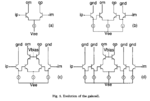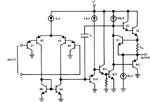prcken
Advanced Member level 1
Hi,
It's my first time to design circuit by using BJTs.
I am doing a CML driver as below

This is simply modified from CMOS CML circuits, but I found it doesn't work at this point, maybe due to the base current (ib) too large? but if I make the size larger to increase beta, the speed maybe affected.
And it's easy to get this error with spectre simulation, I think it's due to improper BJT sizing?

I read reference, there is a picture as below

it says for (a), the input and output capacitances are vastly different. use emitter-followers to drive the input of the current swtiching pair can bring the input and output capacitances closer, like (b). input-output isolation is improved by using common-base stage at the output of the current switch as shown in (c). (d) uses another buffer stage to make the input and output capacitances of the gaincell equal.
No idea how the input and output caps can be made better for equal with emitter-followers.
Anyone had experiences in designing this? or any comments, references?
Thanks!
It's my first time to design circuit by using BJTs.
I am doing a CML driver as below

This is simply modified from CMOS CML circuits, but I found it doesn't work at this point, maybe due to the base current (ib) too large? but if I make the size larger to increase beta, the speed maybe affected.
And it's easy to get this error with spectre simulation, I think it's due to improper BJT sizing?
I read reference, there is a picture as below

it says for (a), the input and output capacitances are vastly different. use emitter-followers to drive the input of the current swtiching pair can bring the input and output capacitances closer, like (b). input-output isolation is improved by using common-base stage at the output of the current switch as shown in (c). (d) uses another buffer stage to make the input and output capacitances of the gaincell equal.
No idea how the input and output caps can be made better for equal with emitter-followers.
Anyone had experiences in designing this? or any comments, references?
Thanks!
Last edited:
